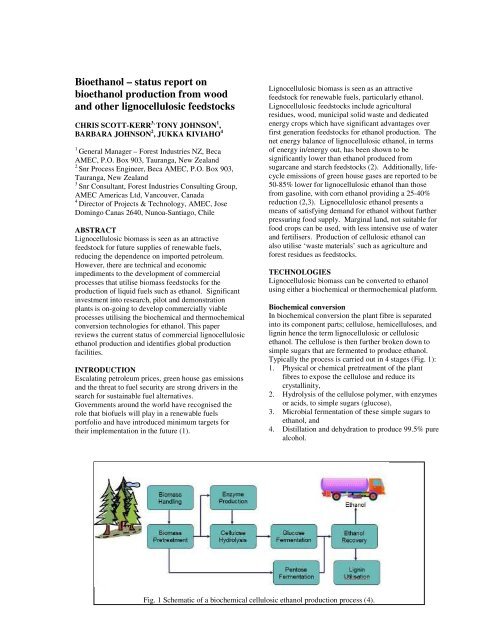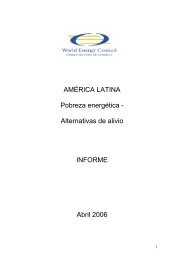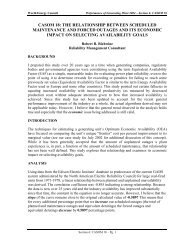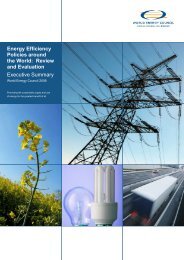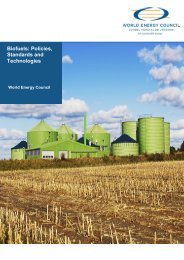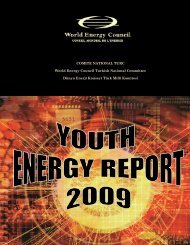Bioethanol – status report on bioethanol production from wood and ...
Bioethanol – status report on bioethanol production from wood and ...
Bioethanol – status report on bioethanol production from wood and ...
You also want an ePaper? Increase the reach of your titles
YUMPU automatically turns print PDFs into web optimized ePapers that Google loves.
<str<strong>on</strong>g>Bioethanol</str<strong>on</strong>g> <str<strong>on</strong>g>–</str<strong>on</strong>g> <str<strong>on</strong>g>status</str<strong>on</strong>g> <str<strong>on</strong>g>report</str<strong>on</strong>g> <strong>on</strong><br />
<strong>bioethanol</strong> producti<strong>on</strong> <strong>from</strong> <strong>wood</strong><br />
<strong>and</strong> other lignocellulosic feedstocks<br />
CHRIS SCOTT-KERR 3, TONY JOHNSON 1 ,<br />
BARBARA JOHNSON 2 , JUKKA KIVIAHO 4<br />
1 General Manager <str<strong>on</strong>g>–</str<strong>on</strong>g> Forest Industries NZ, Beca<br />
AMEC, P.O. Box 903, Tauranga, New Zeal<strong>and</strong><br />
2 Snr Process Engineer, Beca AMEC, P.O. Box 903,<br />
Tauranga, New Zeal<strong>and</strong><br />
3 Snr C<strong>on</strong>sultant, Forest Industries C<strong>on</strong>sulting Group,<br />
AMEC Americas Ltd, Vancouver, Canada<br />
4 Director of Projects & Technology, AMEC, Jose<br />
Domingo Canas 2640, Nunoa-Santiago, Chile<br />
ABSTRACT<br />
Lignocellulosic biomass is seen as an attractive<br />
feedstock for future supplies of renewable fuels,<br />
reducing the dependence <strong>on</strong> imported petroleum.<br />
However, there are technical <strong>and</strong> ec<strong>on</strong>omic<br />
impediments to the development of commercial<br />
processes that utilise biomass feedstocks for the<br />
producti<strong>on</strong> of liquid fuels such as ethanol. Significant<br />
investment into research, pilot <strong>and</strong> dem<strong>on</strong>strati<strong>on</strong><br />
plants is <strong>on</strong>-going to develop commercially viable<br />
processes utilising the biochemical <strong>and</strong> thermochemical<br />
c<strong>on</strong>versi<strong>on</strong> technologies for ethanol. This paper<br />
reviews the current <str<strong>on</strong>g>status</str<strong>on</strong>g> of commercial lignocellulosic<br />
ethanol producti<strong>on</strong> <strong>and</strong> identifies global producti<strong>on</strong><br />
facilities.<br />
INTRODUCTION<br />
Escalating petroleum prices, green house gas emissi<strong>on</strong>s<br />
<strong>and</strong> the threat to fuel security are str<strong>on</strong>g drivers in the<br />
search for sustainable fuel alternatives.<br />
Governments around the world have recognised the<br />
role that biofuels will play in a renewable fuels<br />
portfolio <strong>and</strong> have introduced minimum targets for<br />
their implementati<strong>on</strong> in the future (1).<br />
Lignocellulosic biomass is seen as an attractive<br />
feedstock for renewable fuels, particularly ethanol.<br />
Lignocellulosic feedstocks include agricultural<br />
residues, <strong>wood</strong>, municipal solid waste <strong>and</strong> dedicated<br />
energy crops which have significant advantages over<br />
first generati<strong>on</strong> feedstocks for ethanol producti<strong>on</strong>. The<br />
net energy balance of lignocellulosic ethanol, in terms<br />
of energy in/energy out, has been shown to be<br />
significantly lower than ethanol produced <strong>from</strong><br />
sugarcane <strong>and</strong> starch feedstocks (2). Additi<strong>on</strong>ally, lifecycle<br />
emissi<strong>on</strong>s of green house gases are <str<strong>on</strong>g>report</str<strong>on</strong>g>ed to be<br />
50-85% lower for lignocellulosic ethanol than those<br />
<strong>from</strong> gasoline, with corn ethanol providing a 25-40%<br />
reducti<strong>on</strong> (2,3). Lignocellulosic ethanol presents a<br />
means of satisfying dem<strong>and</strong> for ethanol without further<br />
pressuring food supply. Marginal l<strong>and</strong>, not suitable for<br />
food crops can be used, with less intensive use of water<br />
<strong>and</strong> fertilisers. Producti<strong>on</strong> of cellulosic ethanol can<br />
also utilise ‘waste materials’ such as agriculture <strong>and</strong><br />
forest residues as feedstocks.<br />
TECHNOLOGIES<br />
Lignocellulosic biomass can be c<strong>on</strong>verted to ethanol<br />
using either a biochemical or thermochemical platform.<br />
Biochemical c<strong>on</strong>versi<strong>on</strong><br />
In biochemical c<strong>on</strong>versi<strong>on</strong> the plant fibre is separated<br />
into its comp<strong>on</strong>ent parts; cellulose, hemicelluloses, <strong>and</strong><br />
lignin hence the term lignocellulosic or cellulosic<br />
ethanol. The cellulose is then further broken down to<br />
simple sugars that are fermented to produce ethanol.<br />
Typically the process is carried out in 4 stages (Fig. 1):<br />
1. Physical or chemical pretreatment of the plant<br />
fibres to expose the cellulose <strong>and</strong> reduce its<br />
crystallinity,<br />
2. Hydrolysis of the cellulose polymer, with enzymes<br />
or acids, to simple sugars (glucose),<br />
3. Microbial fermentati<strong>on</strong> of these simple sugars to<br />
ethanol, <strong>and</strong><br />
4. Distillati<strong>on</strong> <strong>and</strong> dehydrati<strong>on</strong> to produce 99.5% pure<br />
alcohol.<br />
Fig. 1 Schematic of a biochemical cellulosic ethanol producti<strong>on</strong> process (4).
Lignin is a byproduct of this process, <strong>and</strong> can be used<br />
as a boiler fuel or processed into specialty chemicals.<br />
Hydrolysis <strong>and</strong> fermentati<strong>on</strong> can be c<strong>on</strong>ducted<br />
simultaneously in <strong>on</strong>e stage but simultaneous<br />
saccharificati<strong>on</strong> <strong>and</strong> fermentati<strong>on</strong> (SSF) is yet to be<br />
implemented commercially, significant advances are<br />
being made in this area.<br />
Thermochemical c<strong>on</strong>versi<strong>on</strong><br />
Thermochemical c<strong>on</strong>versi<strong>on</strong> transforms the<br />
lignocellulosic feedstock into carb<strong>on</strong> m<strong>on</strong>oxide <strong>and</strong><br />
hydrogen (syngas) by partial combusti<strong>on</strong> (Fig. 2).<br />
These gases can be c<strong>on</strong>verted to liquid transportati<strong>on</strong><br />
fuels or commodity chemicals by catalytic or biological<br />
pathways. The biological process c<strong>on</strong>verts carb<strong>on</strong><br />
m<strong>on</strong>oxide to ethanol using a n<strong>on</strong>-yeast fermentati<strong>on</strong><br />
microorganism (eg. Clostridium ljungdahlii).<br />
Alternatively, the syngas can be fed to a catalytic<br />
reactor where the carb<strong>on</strong> m<strong>on</strong>oxide <strong>and</strong> water are<br />
combined via a metal-catalysed process to produce<br />
methanol, ethanol, other higher alcohols or liquid fuels<br />
(Fischer-Tropsch liquids). Gasificati<strong>on</strong> is important<br />
because lignin, which c<strong>on</strong>stitutes about 25 <str<strong>on</strong>g>–</str<strong>on</strong>g> 30% of<br />
cellulosic biomass, is also c<strong>on</strong>verted to syngas <strong>and</strong><br />
subsequently c<strong>on</strong>verted to fuel.<br />
CURRENT STATE OF TECHNOLOGIES AND<br />
TECHNICAL CHALLENGES<br />
Biochemical<br />
Pretreatment - the usefulness of cellulose as a<br />
feedstock has been limited by its rigid structure <strong>and</strong><br />
difficulty to breakdown into simple sugars. Costeffective<br />
pretreatments are needed to liberate the<br />
cellulose <strong>from</strong> the lignin/hemicellulose matrix <strong>and</strong><br />
reduce its crystallinity. Pretreatments of increasing<br />
severity are needed as feedstock recalcitrance increases<br />
<strong>from</strong> n<strong>on</strong><strong>wood</strong>s (agricultural residues) to hard<strong>wood</strong>s to<br />
soft<strong>wood</strong>s.<br />
Many pretreatments are currently being explored,<br />
ranging in chemistries <strong>from</strong> very acidic to mildly<br />
alkaline, such as dilute acid, amm<strong>on</strong>ia fibre expansi<strong>on</strong><br />
(AFEX), wet oxidati<strong>on</strong>, solvent based pulping (i.e.<br />
organosolv) <strong>and</strong> steam explosi<strong>on</strong>. The ideal<br />
pretreatment liberates hemicellulose, exposes the<br />
cellulose <strong>and</strong> allows the lignin to be separated <strong>and</strong> must<br />
also minimise the formati<strong>on</strong> of degradati<strong>on</strong> products<br />
that can inhibit the subsequent hydrolysis <strong>and</strong><br />
fermentati<strong>on</strong> processes.<br />
Lignin <str<strong>on</strong>g>–</str<strong>on</strong>g> As lignin is mainly resp<strong>on</strong>sible for<br />
lignocellulosic recalcitrance, particularly in soft<strong>wood</strong>s,<br />
studies have shown its separati<strong>on</strong> during pretreatment<br />
greatly enhances cellulose accessibility <strong>and</strong> enzyme<br />
effectiveness (6). Pretreatments that minimise lignin<br />
redepositi<strong>on</strong> <strong>and</strong> c<strong>on</strong>densati<strong>on</strong> <strong>on</strong> the fibre surfaces are<br />
favoured. Separati<strong>on</strong> of lignin <strong>and</strong> producti<strong>on</strong> of<br />
specialty lignin co-products also has the potential to<br />
improve the overall ec<strong>on</strong>omics.<br />
Hemicellulose <str<strong>on</strong>g>–</str<strong>on</strong>g>Is composed primarily of 5 carb<strong>on</strong><br />
sugars, these may be liberated during the pre-treatment<br />
process or require further treatment with hemi-cellulase<br />
enzymes. The C5 sugars may be fermented to ethanol<br />
or sold as a co-product.<br />
Hydrolysis - Cellulose is broken down into individual<br />
glucose units by cellulase enzymes, under mild<br />
c<strong>on</strong>diti<strong>on</strong>s. Research is <strong>on</strong>-going to find reduce the<br />
costs of enzyme systems that produce high sugar yields<br />
at accelerated rates <strong>and</strong> without the formati<strong>on</strong> of<br />
inhibitory byproducts. Currently, the per unit cost of<br />
enzymes is c<strong>on</strong>sidered to be a deterrent to the<br />
commercial success of the biochemical pathway.<br />
Alternative strategies to reduce enzyme cost include the<br />
recycling of enzymes <strong>and</strong> the use of polymers to reduce<br />
the binding of enzymes to the substrate (7).<br />
Fig. 2 Schematic of a thermochemical cellulosic ethanol producti<strong>on</strong> process (5).
Fermentati<strong>on</strong> - The hydrolysate c<strong>on</strong>tains both 5-carb<strong>on</strong><br />
(pentose) <strong>and</strong> 6-carb<strong>on</strong> (hexose) sugars. The<br />
c<strong>on</strong>versi<strong>on</strong> of pentose sugars into ethanol is less<br />
efficient than c<strong>on</strong>versi<strong>on</strong> of hexose sugars. A system<br />
of mixed-sugar fermenting microorganisms is required<br />
to utilise the full range of sugars present <strong>and</strong> thus<br />
maximise the producti<strong>on</strong> of ethanol. Metabolic<br />
engineering is <strong>on</strong>-going to find low-cost,<br />
microorganisms capable of C5 <strong>and</strong> C6 sugar cofermentati<strong>on</strong><br />
that are also resistant to inhibitors (acetic<br />
acid, furfural) that may be present.<br />
Thermochemical<br />
C<strong>on</strong>taminati<strong>on</strong> <str<strong>on</strong>g>–</str<strong>on</strong>g> various comp<strong>on</strong>ents of the biomass<br />
feedstock can cause problems in the gasificati<strong>on</strong> <strong>and</strong><br />
catalytic synthesis stages. C<strong>on</strong>taminants such as tars<br />
<strong>and</strong> inorganic comp<strong>on</strong>ents (halides, alkalis, ash) present<br />
in the syngas can deactivate the catalysts <strong>and</strong> must be<br />
removed prior to catalytic c<strong>on</strong>versi<strong>on</strong>. The formati<strong>on</strong> of<br />
tars, <strong>and</strong> measures to deal with their removal, are<br />
significant challenges in biomass gasificati<strong>on</strong>.<br />
Advances in gas clean-up <strong>and</strong> catalyst preparati<strong>on</strong>s are<br />
also needed in order to make large-scale biomass to<br />
liquid facilities practical.<br />
ECONOMICS<br />
Both the biochemical <strong>and</strong> thermochemical pathways<br />
require sophisticated processing steps that have higher<br />
operating costs <strong>and</strong> need significant capital investment<br />
compared with grain-based ethanol processes. Based<br />
<strong>on</strong> the current state of technology, capital costs for<br />
biochemical cellulosic ethanol are estimated to be<br />
between US$4.03 <strong>and</strong> $5.60 per US gall<strong>on</strong> of annual<br />
capacity (8, 9). Operating costs are estimated to be<br />
between US$1.34 <strong>and</strong> $1.69 per US gall<strong>on</strong>, depending<br />
up<strong>on</strong> the assumpti<strong>on</strong>s made about feedstock costs,<br />
enzyme costs, <strong>and</strong> the kind of pretreatment to be<br />
employed (8,9). Projected capital costs for future<br />
plants employing anticipated improvements in<br />
biochemical c<strong>on</strong>versi<strong>on</strong> are estimated to be US$3.33-<br />
4.44 per US gall<strong>on</strong> ethanol annual capacity with<br />
operating costs dropping to US$0.40-0.89 per US<br />
gall<strong>on</strong> of ethanol (10). The US Department of Energy<br />
(DOE) has determined that competitiveness with<br />
petroleum can be achieved at an ethanol producti<strong>on</strong><br />
cost of US$1.07/US gall<strong>on</strong> (in 2002 dollars) <strong>and</strong> aims<br />
to achieve this goal by 2012 (5). This compares to the<br />
producti<strong>on</strong> cost of Brazilian sugarcane ethanol of<br />
US$0.81/gal.<br />
Lignocellulosic based ethanol has a further advantage<br />
over starch based ethanol in that the feed stock is not<br />
commodity based <strong>and</strong> subject to brokers <strong>and</strong> trader<br />
speculati<strong>on</strong> <strong>on</strong> pricing. Lignocellulosic based<br />
feedstocks avoid the arbitrage that starch-based ethanol<br />
is subject to; project developers are better able to<br />
forecast <strong>and</strong> manage feedstock costs reducing project<br />
risk. Many starch-based ethanol producers are<br />
currently struggling to survive <strong>and</strong> many may go<br />
bankrupt due to the volatile swings in corn, wheat,<br />
sugar <strong>and</strong> ethanol prices.<br />
A recent study of the producti<strong>on</strong> of Fischer-Tropsch<br />
(FT) liquids <strong>from</strong> syngas has shown the<br />
thermochemical platform to be ec<strong>on</strong>omically<br />
comparable to the biochemical platforms (8).<br />
CELLULOSIC ETHANOL PLANTS<br />
This secti<strong>on</strong> provides brief details <strong>on</strong> all publically<br />
announced <strong>bioethanol</strong> plants based <strong>on</strong> lignocellulosic<br />
feedstocks. The authors have endeavoured to be<br />
comprehensive but do not guarantee all facilities are<br />
included. Table 1 summarises all known facilities as of<br />
February 2009, <strong>and</strong> these are shown geographically <strong>on</strong><br />
Fig. 4.<br />
Table 1 Lignocellulosic Facilities as at February 2009.<br />
Pilot 1 /<br />
Dem<strong>on</strong>strati<strong>on</strong> 2<br />
Commercial 3<br />
Biochemical 25 9<br />
Thermo Chemical 5 3<br />
Note: 1. Pilot Scale is R&D<br />
2. Dem<strong>on</strong>strati<strong>on</strong> Scale is < 10 ML/yr<br />
3. Commercial Scale is > 10 ML/yr<br />
United States<br />
Currently the US has a target of 136,260 milli<strong>on</strong> litres<br />
per year (ML/yr) of renewable fuels producti<strong>on</strong> by<br />
2022. The US Renewable Fuels St<strong>and</strong>ard calls for<br />
60,560 milli<strong>on</strong> liters to come <strong>from</strong> lignocellulosic<br />
sources. The driving force for this requirement is<br />
primarily energy independence; however green house<br />
reducti<strong>on</strong> is a significant motivating factor for the<br />
inclusi<strong>on</strong> of lignocellulosic based fuel.<br />
Dem<strong>on</strong>strati<strong>on</strong>-scale cellulosic ethanol plants are under<br />
c<strong>on</strong>structi<strong>on</strong> as part of the government’s goal to make<br />
cellulosic ethanol cost competitive by 2012. The plants<br />
cover a wide variety of feedstocks, c<strong>on</strong>versi<strong>on</strong><br />
technologies <strong>and</strong> plant c<strong>on</strong>figurati<strong>on</strong>s to help identify<br />
viable technologies <strong>and</strong> processes for full-scale<br />
commercializati<strong>on</strong>. All dem<strong>on</strong>strati<strong>on</strong> plants, which are<br />
sized at 10% of a commercial-scale biorefinery, are<br />
expected to be operati<strong>on</strong>al by 2012. Commercial-scale<br />
plants are in the planning stages. Dem<strong>on</strong>strati<strong>on</strong> <strong>and</strong><br />
commercial plants include:<br />
• Abengoa - Abengoa is using a $76 milli<strong>on</strong> DOE<br />
grant to develop a 42 ML/yr of cellulosic ethanol<br />
integrated biorefinery, in Hugot<strong>on</strong>, Kansas. The<br />
biomass plant will be situated next to a<br />
c<strong>on</strong>venti<strong>on</strong>al cereal-to-ethanol facility to share<br />
feedstocks, including wheat straw <strong>and</strong> corn stover.<br />
Both enzymatic hydrolysis <strong>and</strong> gasificati<strong>on</strong> will be
part of the integrated biorefinery. Ethanol is<br />
produced through enzymatic hydrolysis, while heat<br />
<strong>and</strong> power are generated using gasificati<strong>on</strong>.<br />
Currently the plant processes 70 tpd of biomass.<br />
The plant is being exp<strong>and</strong>ed to h<strong>and</strong>le up to 1500<br />
tpd. Steam explosi<strong>on</strong> pre-treatment will be used<br />
prior to enzymatic hydrolysis. Since mid-2007,<br />
Abengoa has operated a pilot plant in York, NE<br />
using corn stover. 0.08 ML/yr of ethanol can be<br />
produced using enzymatic hydrolysis <strong>and</strong><br />
fermentati<strong>on</strong> of C5 <strong>and</strong> C6 sugars. Abengoa also<br />
has a dem<strong>on</strong>strati<strong>on</strong> scale plant in Spain (Fig. 3)<br />
•<br />
•<br />
•<br />
•<br />
Fig. 3 Abengoa, Castilla, Spain.<br />
• Alico had partnered with New Planet Energy, LLC<br />
to develop <strong>and</strong> commercialise gasificati<strong>on</strong> <strong>and</strong><br />
biological fermentati<strong>on</strong> of ethanol <strong>from</strong> syngas.<br />
Alico has decided to withdraw <strong>from</strong> this project.<br />
New Plant Energy has partnered with INEOS bio<br />
to INP BioEnergy <strong>and</strong> develop a 30 ML/y<br />
gasificati<strong>on</strong> based project in Florida.<br />
• Alltech, through its subsidiary Ecofin, was<br />
planning to develop a dem<strong>on</strong>strati<strong>on</strong> scale facility<br />
in Kentucky. Plans are currently <strong>on</strong> hold.<br />
• Algenol are developing algae strains to c<strong>on</strong>vert<br />
CO2 to ethanol, using photo-bioreactors they clam<br />
to produce up to 6000 USgal/acre of ethanol.<br />
Algenol have partnerships with Dow Chemical,<br />
Linde Group, Valero <strong>and</strong> Biofields. Algenol have<br />
been selected for a $25 milli<strong>on</strong> DOE biorefinery<br />
grant to be built in Freeport, TX.<br />
• American Energy Enterprises (AEE) has proposed<br />
c<strong>on</strong>structi<strong>on</strong> of a cellulosic ethanol facility in New<br />
Milford, C<strong>on</strong>necticut. The plan is build <strong>on</strong>e<br />
producti<strong>on</strong> line with a capacity of 30 to 38 ML/y<br />
<strong>and</strong> then add additi<strong>on</strong>al lines reaching an ultimate<br />
capacity of 300 to 380 ML/y. AEE intends to use<br />
plant biomass <strong>and</strong> <strong>wood</strong> waste as a feed stock for<br />
the ethanol facility.<br />
• Bluefire Ethanol is developing a 15 ML/yr pilot<br />
facility in Lancaster, CA to dem<strong>on</strong>strate<br />
proprietary c<strong>on</strong>centrated acid hydrolysis. This<br />
facility will focus <strong>on</strong> sorted cellulosic waste<br />
diverted <strong>from</strong> l<strong>and</strong>fills. Bluefire are also<br />
developing a 72 ML/yr dem<strong>on</strong>strati<strong>on</strong> project in<br />
Fult<strong>on</strong>, MS. C<strong>on</strong>centrated acid hydrolysis is<br />
<str<strong>on</strong>g>report</str<strong>on</strong>g>ed to have high sugar yields (>90%) <strong>and</strong> can<br />
be easily adapted to a variety of feedstocks. Acid<br />
recovery <strong>and</strong> h<strong>and</strong>ling have been viewed as<br />
barriers to widespread use of this process.<br />
• Coskata has developed gasificati<strong>on</strong> to ethanol<br />
c<strong>on</strong>versi<strong>on</strong> technology that includes syngas<br />
cleaning, a proprietary syngas fermentati<strong>on</strong><br />
organism <strong>and</strong> ethanol recovery using perevaporati<strong>on</strong>.<br />
Coskata claims to be able to produce<br />
cellulosic ethanol for less than the DOE<br />
benchmark price of US$1.07/US gall<strong>on</strong>. The<br />
Coskata process has been developed quietly,<br />
intenti<strong>on</strong>ally keeping a low profile. Coskata<br />
developers have been awarded 16 patents <strong>and</strong><br />
based <strong>on</strong> Arg<strong>on</strong>ne Nati<strong>on</strong>al laboratory analysis is<br />
showing 7.7 times the energy output to energy<br />
input. Coskata has backing <strong>from</strong> GM <strong>and</strong> Khosla<br />
Ventures. They have c<strong>on</strong>structed <strong>and</strong><br />
commissi<strong>on</strong>ed a semi-commercial dem<strong>on</strong>strati<strong>on</strong><br />
facility at the Westinghouse Plasma facility in<br />
Madis<strong>on</strong>, Pennsylvania. Coskata is developing<br />
plans for a 200 to 400 ML/yr commercial scale<br />
ethanol facility.<br />
• Fulcrum-Bioenergy is developing the Sierra<br />
Biofuels Plant to c<strong>on</strong>vert 90,000 t<strong>on</strong>s per year of<br />
municipal solid waste (MSW) to approximately<br />
40 ML/yr of ethanol. Fulcrum is providing<br />
financing, design <strong>and</strong> c<strong>on</strong>structi<strong>on</strong> services for the<br />
facility to be located near Reno, Nevada. The<br />
Sierra Biofuels project uses a plasma enhanced<br />
gasificati<strong>on</strong> to create syngas <strong>from</strong> MSW <strong>and</strong> a<br />
proprietary catalytic technology to c<strong>on</strong>vert the<br />
syngas to ethanol. Start-up is planned for 2012.<br />
• ICM has received DOE funding to c<strong>on</strong>struct a<br />
10 ML/yr cellulosic ethanol dem<strong>on</strong>strati<strong>on</strong> plant to<br />
be co-located at the existing 190 ML/yr corn-based<br />
ethanol plant in St Joseph Missouri. The facility<br />
will process a variety of feed stocks, including<br />
sorghum <strong>and</strong> switchgrass as well as corn stover<br />
residue. The process utilises biochemical<br />
c<strong>on</strong>versi<strong>on</strong> technology - Novozymes are a<br />
collaborator <str<strong>on</strong>g>–</str<strong>on</strong>g> with simultaneous saccharificati<strong>on</strong><br />
<strong>and</strong> fermentati<strong>on</strong>. Significant benefits are to be<br />
achieved via integrati<strong>on</strong> with the corn-ethanol<br />
process <strong>and</strong> utilizati<strong>on</strong> of the vast amounts of<br />
carb<strong>on</strong> dioxide that are given off. ICM intends to<br />
have the plant operati<strong>on</strong>al by Q4 2010.<br />
• KL Energy have developed a process using a mild<br />
pre-treatment, they operate a 1.0 tpd dem<strong>on</strong>strati<strong>on</strong><br />
plant in Upt<strong>on</strong>, Wyoming. KL Energy has 5<br />
commercial project under development, 2 in the<br />
US <strong>and</strong> 3 in Brazil.<br />
• Mascoma has a dem<strong>on</strong>strati<strong>on</strong> plant (0.8-1.9<br />
ML/yr) in Rome, NY, evaluating multiple<br />
feedstocks including hard<strong>wood</strong>. Biochemical<br />
technology, based <strong>on</strong> thermophilic bacteria is used.
A simple pretreatment step precedes a low-cost<br />
cellulose hydrolysis <strong>and</strong> fermentati<strong>on</strong> C<strong>on</strong>solidated<br />
Bioprocessing stage (CBP). The plant has had a<br />
phased start up <strong>from</strong> June 2008. Mascoma is also<br />
Legend: Thermochemical Biochemical<br />
Pilot / Dem<strong>on</strong>strati<strong>on</strong> Pilot / Dem<strong>on</strong>strati<strong>on</strong><br />
Commercial Commercial<br />
• Pacific Ethanol have signed a memor<strong>and</strong>um of<br />
underst<strong>and</strong>ing with Lignol Energy Corporati<strong>on</strong> to<br />
investigate co-locating a Lignol based Biorefinery<br />
at a Pacific Ethanol facility. Lignol was awarded a<br />
DOE grant for the development of a cellulosic<br />
ethanol dem<strong>on</strong>strati<strong>on</strong> plant.<br />
• POET has a pilot-scale cellulosic ethanol facility in<br />
Scotl<strong>and</strong>, South Dakota. This plant is producing<br />
cellulosic ethanol <strong>from</strong> corn cobs at a cost of $0.62<br />
per l ($2.35/USG). POET is developing Project<br />
Liberty which is a $200+milli<strong>on</strong>/95 ML/y<br />
cellulosic ethanol plant in Emmetsburg, Iowa plant<br />
• Raven BioFuels, Pure Energy, Eco-Energy <strong>and</strong><br />
Price BioStock have partnered to develop two<br />
cellulosic ethanol projects, which are each in<br />
various stages of development:<br />
A 79.5 ML/yr plant based <strong>on</strong> <strong>wood</strong> waste is<br />
being developed in Mississippi <strong>and</strong> will<br />
produce furfural in additi<strong>on</strong> to ethanol.<br />
A memor<strong>and</strong>um of underst<strong>and</strong>ing has been<br />
signed with the Kamloops Indian B<strong>and</strong> in<br />
British Columbia. Biomass suitable for<br />
supporting a 26 ML/yr ethanol facility is part<br />
of the MOU. Furfural, Hydroxymethol<br />
Furfural, lignin cake will also be produced as<br />
part of the process. The PureEnergy Process<br />
uses dilute acid hydrolysis with separate C5<br />
<strong>and</strong> C6 fermentati<strong>on</strong>.<br />
Fig. 4 Global <strong>and</strong> Lignocellulosic Ethanol Facilities<br />
planning a 151 ML/yr commercial development in<br />
Kinross, Michigan by 2012 using the CBP<br />
biochemical process.<br />
• Range Fuels - Range Fuels is building the largest<br />
commercial plant in the USA in Sopert<strong>on</strong>, Georgia.<br />
The site, already under c<strong>on</strong>structi<strong>on</strong>, was to<br />
produce 76 ML/yr by the end of 2009, but now<br />
aims for 38 ML/yr by 2010 before ramping up to<br />
378 ML/yr. This plant uses novel gasificati<strong>on</strong><br />
technology producing syngas <strong>and</strong> then mixedalcohol<br />
synthesis with metal catalysts for methanol<br />
producti<strong>on</strong>. Challenges exist with significant<br />
proporti<strong>on</strong>s of tars <strong>from</strong> biomass as feedstock,<br />
compared to fossil fuels.<br />
• Verenium have partnered with British Petroleum<br />
creating a Joint Venture called Vercepia which is<br />
c<strong>on</strong>structing a 136 ML/y in Highl<strong>and</strong>s Florida,<br />
start up is planned for 2012. Verenium is<br />
operating a 5.5 ML/yr dem<strong>on</strong>strati<strong>on</strong> facility in<br />
Jennings, Louisiana. The dem<strong>on</strong>strati<strong>on</strong> plant is<br />
located adjacent to Verenium’s existing integrated<br />
cellulosic ethanol pilot plant that has been<br />
operati<strong>on</strong>al since 1999 <strong>and</strong> capable of processing<br />
about 2 t/d of biomass. The Verenium process<br />
uses dilute acid hydrolysis followed by steam<br />
explosi<strong>on</strong>, liquid/solid separati<strong>on</strong>, followed by<br />
separate C5 <strong>and</strong> C6 sugar fermentati<strong>on</strong>. Proprietary<br />
enzymes are used for the saccharificati<strong>on</strong> of<br />
cellulose.<br />
• ZEAchem have developed a hybrid process results<br />
in very high yields of ethanol. C5 <strong>and</strong> C6 sugars<br />
are fermented to acetic acid using proprietary
organism which give off no CO2. Acetic acid is<br />
c<strong>on</strong>verted esters which are subsequently<br />
hydrogentated to make ethanol. Hydrogen is<br />
obtained through gasificati<strong>on</strong> of the Lignin<br />
removed <strong>from</strong> the biomass.<br />
Canada<br />
The Canadian government has set it sights <strong>on</strong> a target<br />
of 5% renewable fuel in gasoline by 2010 <strong>and</strong> 2%<br />
renewable fuel in diesel by 2012. To support this, the<br />
federal government has established funding of C$550<br />
milli<strong>on</strong> dollars for pilot plants <strong>and</strong> process development<br />
<strong>and</strong> pre-commercial development, with a further C$500<br />
milli<strong>on</strong> for dem<strong>on</strong>strati<strong>on</strong> scale facilities <strong>and</strong> to assist<br />
with bridging the gap between development <strong>and</strong><br />
commercializati<strong>on</strong> of cellulosic ethanol technologies.<br />
Facilities under c<strong>on</strong>structi<strong>on</strong> or planned (11) include:<br />
• Enerkem, Westbury - A 5 ML/yr cellulosic ethanol<br />
commercial dem<strong>on</strong>strati<strong>on</strong> plant has been<br />
comissi<strong>on</strong>ed by Enerkem in Westbury, Quebec.<br />
The plant will use thermal gasificati<strong>on</strong> <strong>and</strong><br />
catalysis technology to produce ethanol <strong>and</strong><br />
methanol <strong>from</strong> treated <strong>wood</strong> waste (end-of-life<br />
cycle power poles). The methanol <strong>and</strong> ethanol<br />
producti<strong>on</strong> modules are to be added early 2009.<br />
The Enerkem themochemical process yield is 360<br />
L/t <strong>wood</strong> waste. Enerkem has partnered with<br />
GreenField Ethanol, a corn ethanol producer, to<br />
commercialise the Enerkem technology. A 36<br />
ML/yr ethanol/methanol plant is planned for<br />
Edm<strong>on</strong>t<strong>on</strong>, Alberta, utilising sorted municipal solid<br />
waste, start up is scheduled for 2011<br />
• Iogen, Ottawa - Since 2004, Iogen has operated a<br />
dem<strong>on</strong>strati<strong>on</strong>-scale plant in Ottawa producing 2.5<br />
ML/yr of ethanol <strong>from</strong> 30 t/d agricultural residues,<br />
including wheat, oat <strong>and</strong> barley straw. The<br />
technology can also be used successfully with<br />
hard<strong>wood</strong>s, but not soft<strong>wood</strong>s. A modified steam<br />
explosi<strong>on</strong> pretreatment is used to liberate the<br />
cellulose, followed by enzymatic hydrolysis <strong>and</strong><br />
fermentati<strong>on</strong> of both C5 <strong>and</strong> C6 sugars. Ethanol<br />
yields of 340 L/t of fibre, are <str<strong>on</strong>g>report</str<strong>on</strong>g>ed. Lignin is<br />
separated <strong>and</strong> used to generate process steam <strong>and</strong><br />
electricity. Iogen has partnered with Shell since<br />
2002. Iogen’s is working to develop a 70 ML/y<br />
commercial plant in Prince Albert, Sask. The<br />
availability of straw, combined with government<br />
support, were key factors in this decisi<strong>on</strong>. This<br />
will be first facility to take advantage of the<br />
NextGen Biofuels fund.<br />
• Lignol has commissi<strong>on</strong>ed a pilot plant using the<br />
biochem-organosolv process, capable of producing<br />
0.1 ML/yr of ethanol, at their research facilities in<br />
Vancouver, BC. The Alcell technology, originally<br />
developed by General Electric <strong>and</strong> Repap<br />
Enterprises, uses a solvent-based pretreatment <strong>and</strong><br />
produces ethanol <strong>and</strong> High Purity Lignin (HP-L)<br />
<strong>from</strong> hard<strong>wood</strong> <strong>and</strong> soft<strong>wood</strong> residue. Lignol are<br />
working with Pacific Ethanol <strong>on</strong> the development<br />
of a dem<strong>on</strong>strati<strong>on</strong> plant.<br />
Details of facilities under c<strong>on</strong>structi<strong>on</strong> or planned in the<br />
rest of the world are discussed below:<br />
South America<br />
• Brazil is today producing ~ 40% of the world’s<br />
ethanol <strong>from</strong> sugar cane. Yields vary <strong>from</strong> 6,600 <str<strong>on</strong>g>–</str<strong>on</strong>g><br />
7,500 L/ha which means producti<strong>on</strong> costs half<br />
those of US corn-based ethanol processors.<br />
Therefore, there has been relatively low interest in<br />
sec<strong>on</strong>d-generati<strong>on</strong> <strong>bioethanol</strong>. However, recent<br />
studies made by Brazilian Nati<strong>on</strong>al Development<br />
Bank (BNDES) together with FAO show that<br />
when fermenting bagasse <strong>and</strong> sugar cane the<br />
ethanol yield could reach 13,000 L/ha.<br />
• Dedini, Sao Paulo, Brazil - The sugar <strong>and</strong> ethanol<br />
co-operative Copersucar is supporting the Dedini<br />
S/A Indústrias de Base pilot plant using Rapid<br />
Hydrolysis (DRH). The pilot plant started<br />
operati<strong>on</strong>s in 2007 <strong>and</strong> can produce 1.81 ML/yr.<br />
The process uses an initial pretreatment with<br />
organic solvents followed by dilute acid hydrolysis<br />
<strong>and</strong> fermentati<strong>on</strong> stages. C5 <strong>and</strong> C6 sugars are<br />
separated <strong>from</strong> lignin using an acid wash. Dedini<br />
claims a 30% increase in ethanol yields for a<br />
sugar-based ethanol plant with integrati<strong>on</strong> of the<br />
bagasse c<strong>on</strong>versi<strong>on</strong> process. Dedini, the world’s<br />
biggest producer of sugar cane ethanol, expects<br />
start-up of its first commercial scale plant in 2012.<br />
• Chile targets producing sec<strong>on</strong>d-generati<strong>on</strong><br />
<strong>bioethanol</strong> <strong>from</strong> forest biomass within the next five<br />
years. Bioenercel is <strong>on</strong>e of the two c<strong>on</strong>sortiums<br />
created for this development work. It has a fiveyear<br />
budget of US$7 milli<strong>on</strong> <strong>and</strong> is supported by<br />
the Chilean government, two public universities as<br />
well as pulp <strong>and</strong> paper companies Arauco, CMPC<br />
<strong>and</strong> Marisa. Bioenercel is not <strong>on</strong>ly supposed to<br />
develop <strong>and</strong> adapt technologies but also create<br />
necessary infrastructure for <strong>bioethanol</strong> producti<strong>on</strong>.<br />
The current laws in Chile require that, before the<br />
year 2020, 10% of the fuel used by cars will be<br />
replaced by <strong>bioethanol</strong> or biodiesel.<br />
Europe<br />
• Abengoa, Spain - Abengoa Bioenergy has been<br />
operating a biomass-to-ethanol pilot plant since the<br />
end of 2007 at the Biocarburantes Castilla y León<br />
grain-ethanol plant in Babilafuente, near<br />
Salamanca in Spain. 5 ML/yr are produced <strong>from</strong><br />
wheat <strong>and</strong> barley straw using enzymatic hydrolysis<br />
(glucose). A steam explosi<strong>on</strong> pretreatment stage,<br />
<strong>from</strong> SunOpta, is currently being installed <strong>and</strong> will<br />
start up early 2009. In the sec<strong>on</strong>d phase, it is<br />
intended to separate the lignin <strong>and</strong> pentose sugars<br />
as co-products. (See also Abengoa in United<br />
States secti<strong>on</strong>).
• Weyl<strong>and</strong> have developed a c<strong>on</strong>centrated acid<br />
hydrolysis process with very high recovery of acid.<br />
They operate a pilot plant in Bergen, Norway <strong>and</strong><br />
are developing a dem<strong>on</strong>strati<strong>on</strong> scale facility<br />
design to c<strong>on</strong>vert <strong>wood</strong> chips to ethanol. Statoil is<br />
partially funding the project.<br />
• Chemrec, Pitea, Sweden <str<strong>on</strong>g>–</str<strong>on</strong>g> Chemrec has developed<br />
a gasificati<strong>on</strong> process to c<strong>on</strong>vert pulp mill black<br />
liquor (BL) to liquid fuels including ethanol. A<br />
BL gasificati<strong>on</strong> development plant in Pitea,<br />
Sweden is located next to the Smurfit Kappa<br />
Kraftliner mill <strong>and</strong> the research institute ETC. The<br />
gasifier uses pressurized oxygen <strong>and</strong> is capable of<br />
gasifying 20 t BLS/d, producing a synthesis gas<br />
that requires little cleanup. Chemrec are currently<br />
involved in supplying Dimethyl Ether (DME) for 1<br />
year pilot project. This project will make DME<br />
<strong>from</strong> Gasified black liquor to determine the<br />
viability of biomass produced DME as a diesel<br />
substitute. A commercial-scale BL liquor<br />
gasificati<strong>on</strong> plant has been operating at<br />
Weyerhauser’s New Bern mill in the US since<br />
1996, <strong>and</strong> was rebuilt in 2003 increasing capacity<br />
to 300 t BLS/d (Fig. 5). Integrati<strong>on</strong> of a BL<br />
gasifier allows mills to produce liquid fuels <strong>and</strong><br />
increase recovery capacity. At the New Bern mill<br />
the unit provides 15% of the mills BL recovery<br />
capacity.<br />
• Chempolis have developed a unique pulping<br />
process using formic acid that creates a clean<br />
cellulose suitable for c<strong>on</strong>versi<strong>on</strong> to ethanol. The<br />
formicobio process produces fuel grade ethanol<br />
<strong>from</strong> <strong>wood</strong> <strong>and</strong> n<strong>on</strong>-<strong>wood</strong> sources.<br />
• St1 out of Finl<strong>and</strong> has developed two processes: a<br />
food waste to ethanol processes, Etanolix® <strong>and</strong> a<br />
variati<strong>on</strong> which c<strong>on</strong>verts <strong>wood</strong>y biomass to<br />
ethanol named Bi<strong>on</strong>olix.<br />
• SEKAB, Ornskoldsvik, Sweden <str<strong>on</strong>g>–</str<strong>on</strong>g> SEKAB, in<br />
c<strong>on</strong>juncti<strong>on</strong> with Etek Etanolteknik AB, has been<br />
operating a <strong>bioethanol</strong> pilot plant since 2004 at its<br />
Domsjo industrial site. The feedstock is pine <strong>wood</strong><br />
chips, but other biomass such as bagasse, wheat<br />
<strong>and</strong> corn stover, energy grasses <strong>and</strong> recycled waste<br />
can be used. The plant has a maximum <strong>wood</strong><br />
capacity of 2 BDT/d <strong>and</strong> ethanol producti<strong>on</strong> of<br />
0.14 ML/yr. The process is based <strong>on</strong> multi-stage<br />
weak acid hydrolysis, a detoxificati<strong>on</strong> stage prior<br />
to fermentati<strong>on</strong>, <strong>and</strong> separati<strong>on</strong> of lignin using a<br />
membrane filter. Recent work has focused <strong>on</strong><br />
improving the ethanol yield using pentosefermenting<br />
microorganisms. For cost reas<strong>on</strong>s,<br />
enzymes are not used. Scale-up of this technology<br />
is planned for 2010-11 with the c<strong>on</strong>structi<strong>on</strong> of a<br />
development facility of 6 ML/yr <strong>and</strong> a 120 ML/yr<br />
commercial plant in 2014, utilising <strong>wood</strong> waste<br />
<strong>and</strong> sugarcane bagasse.<br />
• Stora Enso, Varkaus, Finl<strong>and</strong> - Plans have been<br />
announced to build a dem<strong>on</strong>strati<strong>on</strong> gasificati<strong>on</strong><br />
plant at the research centre at Varkaus mill for the<br />
producti<strong>on</strong> of biofuels <strong>from</strong> <strong>wood</strong> residues. This is<br />
a joint venture between Stora Enso Oyj <strong>and</strong> Neste<br />
Oil Corporati<strong>on</strong>.<br />
• UPM Kymmene, Finl<strong>and</strong> <str<strong>on</strong>g>–</str<strong>on</strong>g> Finnish pulp <strong>and</strong> paper<br />
company UPM Kymmene <strong>and</strong> renewable fuel<br />
supplier Lassila <strong>and</strong> Tikanoja are testing<br />
<strong>bioethanol</strong> producti<strong>on</strong> <strong>from</strong> the pulp-based waste<br />
created by the paper industry. During the pilot<br />
tests ethanol <strong>and</strong> energy were produced <strong>from</strong><br />
commercial <strong>and</strong> industrial waste, such as paper,<br />
cardboard <strong>and</strong> <strong>wood</strong>. By developing waste<br />
processing units, energy company St1’s biofuel<br />
divisi<strong>on</strong> intends to produce 70 ML/yr of <strong>bioethanol</strong><br />
by the end of 2011. St1 already has two<br />
commercial plants operating using food industry<br />
waste as raw material. UPM is also developing<br />
project for the producti<strong>on</strong> of Bio-oil <strong>and</strong> Fischer<br />
Tropsch liquids.<br />
Fig. 5 Weyerhauser, New Bern, USA<br />
• INBICON, a subsidiary of DONG energy<br />
Denmark, grew out the Elsam work <strong>on</strong> agriculture<br />
residues to ethanol. Inbic<strong>on</strong> have commissi<strong>on</strong>ed a<br />
commercial dem<strong>on</strong>strati<strong>on</strong> plant at the Kalundborg<br />
coal fired power stati<strong>on</strong>. The commercial<br />
dem<strong>on</strong>strati<strong>on</strong> plant c<strong>on</strong>verts 30,000 tpy of straw<br />
to 5.4 Ml of ethanol, 13,100 t of lignin <strong>and</strong> 11,250<br />
t of C5 molasses. The principal purpose of the<br />
dem<strong>on</strong>strati<strong>on</strong> plant is to show that DONG<br />
Energy’s sec<strong>on</strong>d-generati<strong>on</strong> technology can be<br />
applied <strong>on</strong> a large scale, <strong>and</strong> can be integrated with<br />
a power stati<strong>on</strong>. Inbic<strong>on</strong>, Great River Energy <strong>and</strong><br />
Otoka are currently developing plans for a<br />
commercial cellulosic ethanol plant which will<br />
c<strong>on</strong>sume 400,000 tpy of wheat straw <strong>and</strong> will be<br />
located in North Dakota.<br />
• BioGasol is c<strong>on</strong>structing a 5 ML/yr dem<strong>on</strong>strati<strong>on</strong><br />
plant in Denmark, called the BornBioFuel (BBF)<br />
project. The plant, located <strong>on</strong> the isl<strong>and</strong> of<br />
Bornholm, will dem<strong>on</strong>strate the potential of the<br />
Biogasol technology (see Pacific Ethanol) to<br />
produce ethanol <strong>from</strong> a diverse mixture of<br />
biomass, including local available agricultural<br />
residues <strong>and</strong> other low cost cellulosic feedstocks.
• HCL Technologies out of Israel are implementing<br />
a c<strong>on</strong>centrated hydrochloric acid hydrolysis of<br />
<strong>wood</strong>y biomass. The focus is <strong>on</strong> cost reducti<strong>on</strong><br />
<strong>and</strong> technology improvement. The pilot plant will<br />
be built at the Southern Research Institute in North<br />
Carolina.<br />
• TMO Renewables, Guildford, UK - The UK's first<br />
cellulosic ethanol dem<strong>on</strong>strati<strong>on</strong> facility has been<br />
built using biochemical c<strong>on</strong>versi<strong>on</strong> which<br />
incorporates their unique thermophilic bacterium<br />
for fermentati<strong>on</strong> at 60-70ºC. Feedstocks that can<br />
be processed include agricultural waste, <strong>wood</strong><br />
chips, paper <strong>and</strong> municipal waste.<br />
Japan, Australasia, Asia<br />
• BioEthanol Japan - The BioEthanol Japan plant in<br />
Osaka Prefecture has capacity of 1.4 ML/yr <strong>and</strong><br />
had plans to boost producti<strong>on</strong> to 4 ML/yr in 2008.<br />
Wood c<strong>on</strong>structi<strong>on</strong> waste is used as feedstock <strong>and</strong><br />
technology <strong>from</strong> Verenium.<br />
• COFCO/Sinopec <strong>and</strong> Novozymes are collaborating<br />
to build a dem<strong>on</strong>strati<strong>on</strong> cellulosic ethanol plant in<br />
Zhaod<strong>on</strong>g, Heil<strong>on</strong>gjiang province. The feedstock<br />
will be corn stover <strong>and</strong> corn cobs.<br />
• H<strong>on</strong>da-RITE, Japan - collaborati<strong>on</strong> between<br />
H<strong>on</strong>da <strong>and</strong> RITE (Research Institute of Innovative<br />
Technology for the Earth) aims to initially develop<br />
laboratory scale producti<strong>on</strong> of cellulosic ethanol<br />
using biochemical process, with scale up to pilot<br />
plant size envisaged.<br />
• Marubeni, Saraburi, Thail<strong>and</strong> <str<strong>on</strong>g>–</str<strong>on</strong>g> A 3 ML/yr<br />
cellulosic ethanol plant was opened in late 2008<br />
co-located with a sugarcane-ethanol plant<br />
(Marubeni <strong>and</strong> Tsukishima Kikai Co Ltd). The<br />
sugarcane bagasse will be the primary feedstock<br />
<strong>and</strong> Verenium’s process technology will be used.<br />
• China Resources Alcohol Corporati<strong>on</strong>, China -<br />
CRAC is the sec<strong>on</strong>d largest ethanol producer in<br />
China <strong>and</strong> has been operating a cellulosic ethanol<br />
pilot plant in ZhaoD<strong>on</strong>g City, since 2006. Corn<br />
stover feedstock is processed using SunOpta’s<br />
modified steam explosi<strong>on</strong> technology followed by<br />
enzymatic hydrolysis. CRAC's goal was to install<br />
6 ML/yr of cellulosic ethanol capacity by the end<br />
of 2007 <strong>and</strong> 1,250 ML/yr by 2012, the most<br />
ambitious target in the world.<br />
• Missi<strong>on</strong> NewEnergy, India <str<strong>on</strong>g>–</str<strong>on</strong>g> A pilot plant of 0.07<br />
ML/yr cellulosic ethanol utilises agricultural waste<br />
(wheat/rice/corn/barley straw, <strong>and</strong> in the future<br />
Jatropha Curcas, an oil-seed tree) using a novel<br />
hydrolysis process. Lignin is separated <strong>from</strong> the<br />
cellulose <strong>and</strong> hemicellulose prior to hydrolysis,<br />
which is c<strong>on</strong>ducted without the use of any<br />
enzymes. Yields of 500 L/t of feedstock are<br />
<str<strong>on</strong>g>report</str<strong>on</strong>g>ed which is 36% more efficient than<br />
competing cellulosic ethanol technologies. A<br />
commercial scale plant is planned.<br />
• Ethtec, Australia - Ethtec, a Willmott Forests<br />
subsidiary, is currently c<strong>on</strong>structing a pilot plant<br />
for cellulosic ethanol producti<strong>on</strong> at the NSW Sugar<br />
Milling Co-operative Har<strong>wood</strong> Mill <strong>and</strong> Refinery<br />
near Maclean in northern NSW. The plant will use<br />
hydrolysis <strong>and</strong> fermentati<strong>on</strong> technology developed<br />
in collaborati<strong>on</strong> with the University of Southern<br />
Mississippi <strong>and</strong> the University of New South<br />
Wales. The process uses ‘induced phase<br />
separati<strong>on</strong>’ for recovery of ethanol eliminating the<br />
need for c<strong>on</strong>venti<strong>on</strong>al distillati<strong>on</strong>, significantly<br />
improving the energy balance of the process <strong>and</strong><br />
reducing the envir<strong>on</strong>mental impact of the distillery.<br />
It is planned to use <strong>wood</strong> residues (including pine),<br />
bagasse <strong>and</strong> other biomass for the producti<strong>on</strong> of<br />
ethanol.<br />
• Pure Power, Singapore <str<strong>on</strong>g>–</str<strong>on</strong>g> Pure Power has<br />
purchased the NZ-based BioJoule lignocellulosic<br />
c<strong>on</strong>versi<strong>on</strong> technology for the producti<strong>on</strong> of<br />
<strong>bioethanol</strong>, natural lignin <strong>and</strong> xylose. The intended<br />
feedstock is the <strong>wood</strong> crop Salix, a variety of<br />
willow. A unique washing process is used to<br />
preserve <strong>and</strong> recover the lignin which can be used<br />
in paints, glues, resins <strong>and</strong> other phenolic<br />
chemicals which are currently derived <strong>from</strong><br />
petroleum. It is estimated that 80% of the overall<br />
revenue will be derived <strong>from</strong> the lignin <strong>and</strong> xylose<br />
by-products<br />
• LanzaTech, New Zeal<strong>and</strong> <str<strong>on</strong>g>–</str<strong>on</strong>g> This start-up energy<br />
company has dem<strong>on</strong>strated the microbial<br />
c<strong>on</strong>versi<strong>on</strong> of carb<strong>on</strong> m<strong>on</strong>oxide into ethanol. The<br />
company envisages that the process can be<br />
retrofitted to any industrial facility to generate<br />
ethanol <strong>from</strong> the carb<strong>on</strong> m<strong>on</strong>oxide comp<strong>on</strong>ent of<br />
high volume waste flue gases. Scaling-up of the<br />
technology is planned.<br />
• Sci<strong>on</strong>, Rotorua, New Zeal<strong>and</strong> <str<strong>on</strong>g>–</str<strong>on</strong>g> The<br />
Lignocellulosic <str<strong>on</strong>g>Bioethanol</str<strong>on</strong>g> Initiative is a<br />
collaborati<strong>on</strong> between Sci<strong>on</strong>, Verenium, Carter<br />
Holt Harvey, BP <strong>and</strong> Beca AMEC that is<br />
developing a biochemical route using soft<strong>wood</strong>s<br />
for ethanol producti<strong>on</strong>. A pilot plant is being<br />
developed.<br />
SUMMARY<br />
Substantial investment is occurring in c<strong>on</strong>versi<strong>on</strong><br />
technologies <strong>and</strong> in determining the most ec<strong>on</strong>omic,<br />
practical <strong>and</strong> cleanest technology for the producti<strong>on</strong> of<br />
cellulosic ethanol. Pilot plants have successfully<br />
dem<strong>on</strong>strated the producti<strong>on</strong> of ethanol <strong>from</strong><br />
feedstocks, such as agricultural waste, but the<br />
c<strong>on</strong>versi<strong>on</strong> of <strong>wood</strong> waste, particularly soft<strong>wood</strong>s,<br />
c<strong>on</strong>tinues to be more challenging.<br />
It is likely there will be no single preferred c<strong>on</strong>versi<strong>on</strong><br />
technologies for the producti<strong>on</strong> of cellulosic ethanol,<br />
but rather technologies appropriate for specific<br />
feedstocks. For example, the high ash c<strong>on</strong>tent of many
straws may prohibit their utilisati<strong>on</strong> in the gasificati<strong>on</strong><br />
pathway, but these feedstocks show high c<strong>on</strong>versi<strong>on</strong><br />
yields using enzymatic hydrolysis technologies.<br />
C<strong>on</strong>structi<strong>on</strong> of the first large-scale dem<strong>on</strong>strati<strong>on</strong><br />
facilities is underway. The success of these plants in<br />
dem<strong>on</strong>strating a cost-effective sustainable c<strong>on</strong>versi<strong>on</strong><br />
process for ethanol will open the way to the<br />
commercialisati<strong>on</strong> of sec<strong>on</strong>d generati<strong>on</strong> biofuels.<br />
Significant reducti<strong>on</strong>s in operating costs are needed to<br />
achieve the goal of producing cellulosic ethanol for less<br />
than US$1.07/US gall<strong>on</strong>. The availability <strong>and</strong> cost of<br />
raw materials will determine the size of the plant <str<strong>on</strong>g>–</str<strong>on</strong>g><br />
more expensive biomass will require larger facilities in<br />
order to offset the cost of the investment. The<br />
availability of financing, particularly the willingness of<br />
governments to share in the scale-up risks with private<br />
industry, will also be critical to commercialisati<strong>on</strong>. Colocati<strong>on</strong><br />
with existing infrastructure <strong>and</strong> facilities, such<br />
as power plants, grain-ethanol plants, pulp <strong>and</strong> paper<br />
mills, where various synergies can be achieved, has<br />
many advantages over st<strong>and</strong>-al<strong>on</strong>e plants.<br />
REFERENCES<br />
1. US C<strong>on</strong>gress, Energy Independence <strong>and</strong> Security<br />
Act of 2007, p.1491 (2007).<br />
2. Hayes, D.J. An examinati<strong>on</strong> of biorefining<br />
processes, catalysts <strong>and</strong> challenges, Catalysis<br />
Today, June (2008).<br />
3. IEA, Internati<strong>on</strong>al Energy Agency. Biofuels for<br />
Transport: An internati<strong>on</strong>al perspective (2004).<br />
www.iea.org<br />
4. Renewable Fuels. http://www.renew-fuel.com/<br />
5. Research Advances, Cellulosic ethanol, Nati<strong>on</strong>al<br />
Renewable Energy Laboratory,<br />
6. http://www.nrel.gov/biomass/pdfs/40742.pdf<br />
7. Mabee, W.E., Gregg, D.J., Arato, C. Updates <strong>on</strong><br />
soft<strong>wood</strong>-to-ethanol process development, Applied<br />
Biochem & Biotech, Vol 129-132:55 (2006).<br />
8. Gray, K.A., Zhao, L., Emptage, M. <str<strong>on</strong>g>Bioethanol</str<strong>on</strong>g>,<br />
Current Opini<strong>on</strong> in Chemical Biology, 10(2): 141<br />
(2006).<br />
9. Wright, M.M. <strong>and</strong> Brown, R.C. Comparative<br />
ec<strong>on</strong>omics of biorefineries based <strong>on</strong> the<br />
biochemical <strong>and</strong> thermochemical platforms,<br />
Biofuels, Bioprod. Bioref. 1:49 (2007).<br />
10. Aden A, Ruth M, Ibsen K, Jechura J, Neeves K, et<br />
al., Lignocellulosic biomass to ethanol process<br />
design <strong>and</strong> ec<strong>on</strong>omics utilising co-current dilute<br />
acid prehydrolysis <strong>and</strong> enzymatic hydrolysis for<br />
corn stover. Nati<strong>on</strong>al Renewable Energy<br />
Laboratory, Report NREL/TP-510-32438, June<br />
(2002).<br />
11. Wood, Susan M. <strong>and</strong> Layzell, David B. BIOCAP<br />
<str<strong>on</strong>g>report</str<strong>on</strong>g>, June 27, 2003 A Canadian biomass<br />
Inventory: Feeds for a Bio-based Ec<strong>on</strong>omy.


